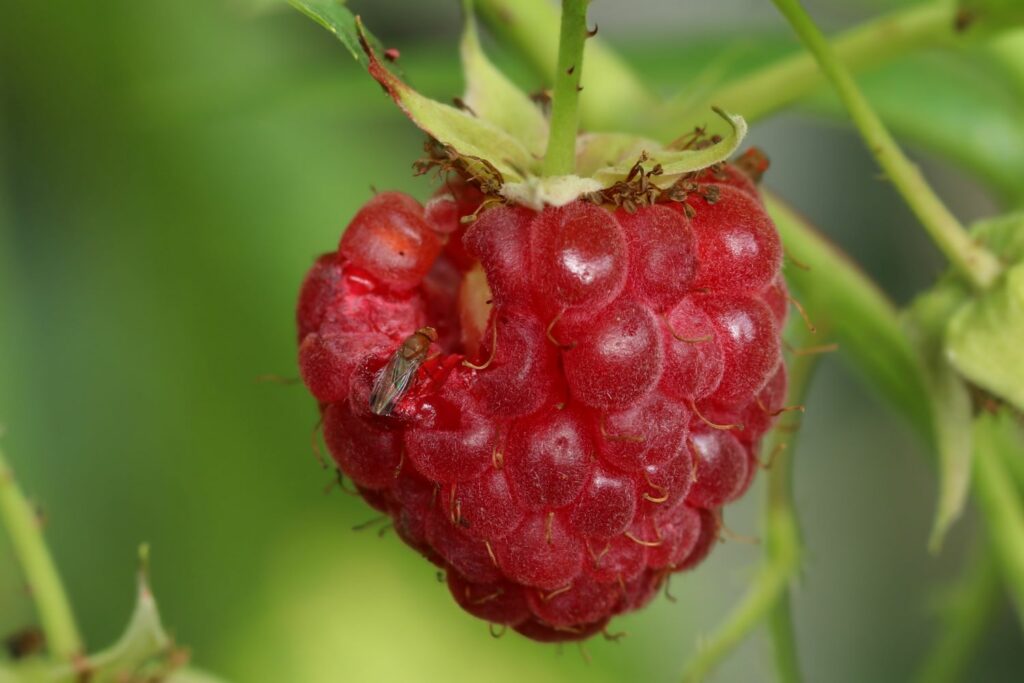Up to 60% reduction in SWD control costs with new food bait adjuvant
16th December 2022
Field trials have shown that using ProBandz, a new food bait adjuvant for spotted wing drosophila (SWD) control, is significantly more cost-effective than full foliar sprays while being harmless to pollinators and other beneficial insects.

Clare Sampson, technical director at Russell IPM, talked about how ProBandz could revolutionise SWD control at the NIAB Soft Fruit Day technical webinar on 30th November.
Ms Sampson began by highlighting that SWD management can be very time-consuming and costly to growers, and is still quite reliant on routine insecticide treatment. Other than being a substantial expense, full-rate insecticides may also impact natural predator establishment and therefore have an effect on thrips and aphid control in fruit crops.
ProBandz is a new food bait adjuvant approved for use in the UK, which works by stimulating the feeding of SWD to promote greater pesticide uptake and rapid mortality.
The product must first be mixed with water at a 1:1 ratio, which takes about three minutes at room temperature. It can then be added to the spray tank with the approved plant protection product, the rate of which must not exceed 50% (a much lower rate of 4% is recommended).
According to Ms Sampson, ProBandz is ideal for use as a band treatment to reduce costs and the impact on beneficial insects. The adjuvant proved to be effective at reducing SWD numbers in two field trials, which were an offshoot of an Innovate UK project also looking at biopesticides.
Semi-field scale trial at NIAB on strawberry
The first trial to test the efficacy of ProBandz in SWD control applied three treatments on strawberry crops:
- Untreated control with SWD released
- Full foliar sprays of Tracer and Exirel, with a spray volume of 500L/ha
- Probandz 5% v/v, reduced rates (4%) of Tracer and Exirel, 40L/ha
Each of these treatments had four replicates, with SWD introduced during the first and second weeks. Insecticide was applied weekly, alternating between the two chemicals.
During the course of the trial, weekly assessment of the fruit crop was carried out by NIAB using the fruit floatation technique, allowing SWD to be collected and counted.
The results have shown that both the insecticide and ProBandz treatment significantly reduced the SWD larvae population, by 77% and 80%, respectively. Ms Sampson reiterated the cost-effectiveness of the bait spray that was applied with a low 4% insecticide rate and spray volume of only 40L/ha.
Field-scale commercial raspberry trial with Berry Gardens
The second field trial conducted in collaboration with Berry Gardens used four replicate plots of full foliar sprays and six replicates of ProBandz treatments. The chemicals, mixing rates and volumes used were the same as in the first trial, with the sprays applied at weekly intervals.
Due to the facility being a commercial production unit, there were no control plots in this trial and only naturally occurring SWD was observed, Ms Sampson explained. SWD populations were once again assessed weekly and larvae counted using the fruit floatation technique.
Ms Sampson pointed out that slightly larger droplets were needed with the bait spray to encourage SWD to come and feed on the product. To achieve this, bait spray applicators were fitted with a different nozzle type than full-rate sprays, producing droplets the size of 340 microns as opposed to 154-225 microns.
In addition, bait sprays were only applied to a one-metre band across the middle of the raspberry plant canopies (below flower level), while full-rate sprays were applied to the entire canopy.
Similar to the first trial, Ms Sampson and her team found no significant difference between the efficiency of the two sprays. Moreover, following bait spraying, bees and pollinators were observed to move immediately onto the flowers of crops.
Summarising the benefits of ProBandz based on the trials, Ms Sampson highlighted that reduced rate applications of insecticide with the adjuvant were as effective as full field rates. With bait sprays using 96% less insecticide, this amounts to an estimated 60% reduction in cost to growers, Ms Sampson noted.
Moreover, pesticide residues in fruit crops that received the full rate treatment were eleven times higher than in bait spray plots. The area covered by bait sprays was also eight times lower than with full-rate sprays, meaning less time and fuel is required to achieve the same results.
Ultimately, using band treatment of ProBandz bait sprays reduces grower costs and lowers the environmental impact of pesticides, yet can achieve equal or better SWD control, Ms Sampson concluded.
